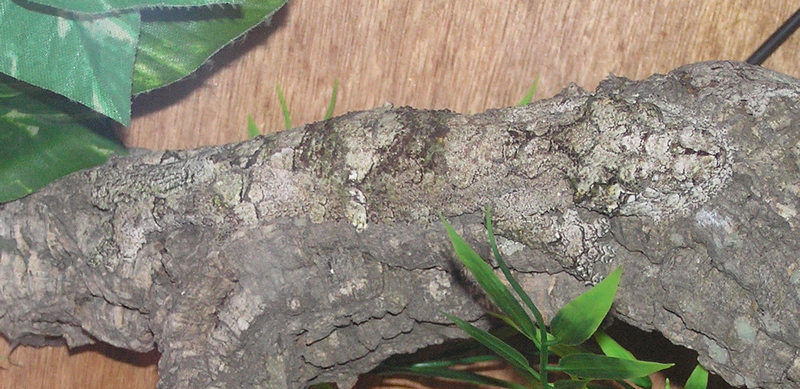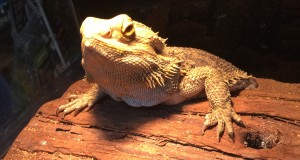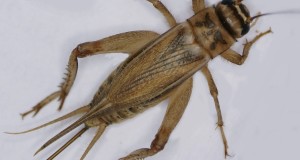The Nosy Be Gecko (Uroplatus ebenaui) is one of the most interesting recent newcomers to the pet trade. However, its unique appearance should not prompt you into a quick purchase, as we have a great deal yet to learn about its care. Today I’d like to review its natural history, as therein lay the key to its proper captive care. In Part II of this article we’ll look at some of \this lizard’s interesting relatives.
Description
The Nosy Be Gecko is tan, gray, orange-brown or dark brown in color, with a reticulating dark pattern, skin projections and a short, pointed tail; the over-all appearance is remarkably similar to that of a decaying leaf.
At 2-4 inches in length, it is the smallest member of its genus.
Range
This lizard is known only from the Nosy Be region of northeastern Madagascar.
Habitat
The Nosy Be Gecko is restricted to cool, humid rainforests. It is entirely arboreal and nocturnal and, unlike most lizards, prefers temperatures of 68-75F.
Status in the Wild
This species is largely unstudied, but is believed threatened due to extensive deforestation within its extremely limited natural range. It is listed on CITES Appendix II.
Reproduction
 Little is known of the Nosy Be Gecko’s reproductive biology in the wild. In captivity, females lay multiple clutches of 2-4 eggs during the spring and summer.
Little is known of the Nosy Be Gecko’s reproductive biology in the wild. In captivity, females lay multiple clutches of 2-4 eggs during the spring and summer.
Despite being persistently arboreal, females descend to the ground and bury the eggs in moist earth or below leaf litter. Mature eggs can be seen through the abdominal skin of the females. The eggs hatch in 3-6 months, depending upon temperature, and the young reach adult size in approximately 7 months.
Diet
Nosy Be Geckos prey upon moths, caterpillars, spiders, beetles, tree crickets and other invertebrates. Related species take ripe fruit, sap, nectar and snails, but these items are usually refused by captive Nosy Be Geckos.
Defense
When threatened, the Nosy Be Gecko hangs head-down by the rear feet, further enhancing its resemblance to a dead leaf.
Further Reading
You can read more about the 12 Leaf-tailed Geckos here.
 That Reptile Blog – Reptile, Amphibian and Exotic Pet Care and Information
That Reptile Blog – Reptile, Amphibian and Exotic Pet Care and Information



Oh MY! That pic of it on the branch is AMAZING! Very interesting creature! I’m looking forward to reading part two.
Hello, Frank Indiviglio here.
Thanks for your interest in our blog and the kind words. Yes, if any creatures can be called “otherworldly”, it is these little fellows! If you are interested in geckos, you might enjoy this article on the New Caledonian Giant Gecko as well.
Enjoy and please keep me posted.
Best regards, Frank Indiviglio.
Good species to highlight Frank! I’ve always admired these from a distance-the temp requirements, prices, and difficulties in acclimating wild caughts have made me decide they are best left to others. Real shame what is going on in Madagascar.
I think the pictures vs the species are mixed though. Uroplatus ebenaui is known in the hobby as the spearpoint leaftail and looks similar to the Satanic leaftail(U. phantasticus)…the photos seem to be of one of the larger species(U. fimbriatus, perhaps)?…displaying superb camouflage. Would you agree that Uroplatus display the most highly evolved crypsis of all the geckos?(and probably any reptile, actually). I’ve wondered it it has to do with more intense selection than usual due to particularly keen eyed diurnal visual predators(lemurs, perhaps?)
All the Best
~Joseph
Hello Joseph, Frank Indiviglio here.
Interesting point re keen-eyed predators, I agree; I’d be hard-pressed to find a better-camouflaged reptile. You’re rather keen-eyed yourself – the photos do show U. fimbriatus; I didn’t have any of the highlighted species, and neglected to point that out – thank you.
Good luck and please keep me posted.
Best regards, Frank Indiviglio.
Very nice Frank! THis is one of my favorite Uroplatus! I have seen so many color variations of this species. My ultamate fav is Uroplatus sikorae they are so cooool!\
Ari Flagle
Hello Ari,
Thanks for the note; I’m getting some photos together and hope to post another article soon,
Good luck and please keep me posted.
Best regards, Frank Indiviglio.
Oh my word, it blended in so perfectly with the branch, it took me like 5mins to figure it out, amazing creature